Register a SNAP EBT card with Amazon

Create an Amazon Business Account
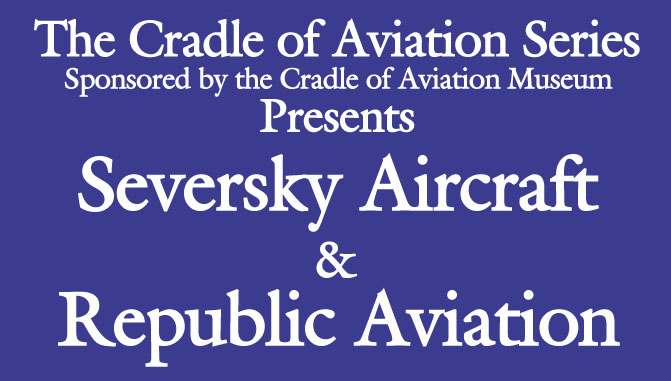 P-47 Thunderbolt: Aviation Darwinism
Chapter Four:
While the first P-47B aircraft were being extensively tested, Republic was hard at work at getting production underway in the new plant
building just completed at Farmingdale.
In addition to this, the first of three new paved runways were completed. Ultimately, expansion of this Long Island facility would
quadruple the size of the factory floor space.
Nonetheless, all of this new construction would not be enough to meet the future contract demands for the Thunderbolt. In November of 1942 the
War Production Board authorized a new plant to be constructed adjacent to the Evansville, Indiana airport.
This would provide the critical production volume that would enable the P-47 to the most produced American
fighter of World War Two. Production would ramp up slowly, largely a result of the extensive testing involved. Despite getting off to a
slow start, by the middle of 1943, Thunderbolts would be rolling off the factory floor at a rate never envisioned just two years before.
Shortly after the first YP-47B rolled out of the plant in November of 1941, the United States would find itself at war with both Japan and
Germany. This only hastened further development of the P-47. An uprated and lighter version of the Pratt
& Whitney R-2800 engine was installed in the early P-47B aircraft.
This provided for even better speed at altitude and a small improvement in climb rate.
If there was any area where the P-47B was less than sterling, it was its rather poor rate of climb.
Yet, this was not as great a concern as some might think.
Ultimately, the P-47 would be used in a role where climb ability was not especially critical to performing its mission.
P-47 Thunderbolt: Aviation Darwinism
Chapter Four:
While the first P-47B aircraft were being extensively tested, Republic was hard at work at getting production underway in the new plant
building just completed at Farmingdale.
In addition to this, the first of three new paved runways were completed. Ultimately, expansion of this Long Island facility would
quadruple the size of the factory floor space.
Nonetheless, all of this new construction would not be enough to meet the future contract demands for the Thunderbolt. In November of 1942 the
War Production Board authorized a new plant to be constructed adjacent to the Evansville, Indiana airport.
This would provide the critical production volume that would enable the P-47 to the most produced American
fighter of World War Two. Production would ramp up slowly, largely a result of the extensive testing involved. Despite getting off to a
slow start, by the middle of 1943, Thunderbolts would be rolling off the factory floor at a rate never envisioned just two years before.
Shortly after the first YP-47B rolled out of the plant in November of 1941, the United States would find itself at war with both Japan and
Germany. This only hastened further development of the P-47. An uprated and lighter version of the Pratt
& Whitney R-2800 engine was installed in the early P-47B aircraft.
This provided for even better speed at altitude and a small improvement in climb rate.
If there was any area where the P-47B was less than sterling, it was its rather poor rate of climb.
Yet, this was not as great a concern as some might think.
Ultimately, the P-47 would be used in a role where climb ability was not especially critical to performing its mission.
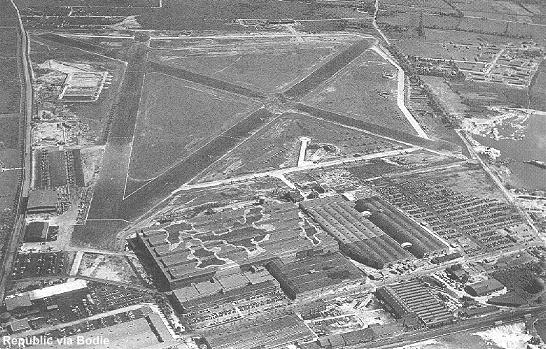 Republic's Farmingdale facility as it appeared from the air in mid 1943.
Republic's Farmingdale facility as it appeared from the air in mid 1943.
The total area of manufacturing space had quadrupled since the beginning of 1941.
By early June 1942, the first batch of 37 P-47B’s were issued to the
56th Fighter Group, with the 63rd Fighter Squadron being stationed at
Republic’s Farmingdale airfield. One problem faced almost
immediately involved the difficulty of changing engines on the B model
Thunderbolts. Maintenance crews were finding this operation to be very
time consuming. Republic responded with their first major
change to the P-47 airframe. An 8-inch extension of the fuselage,
forward of firewall allowed for a new Quick Engine Change (QEC) design
that cut the time required to hang a new engine by better than 60%.
Not only did the lengthened fuselage aid normal maintenance; it improved
the handling and maneuverability. This change was introduced shortly
after the C model began production. Virtually every Thunderbolt
previously manufactured was retrofitted with this change.
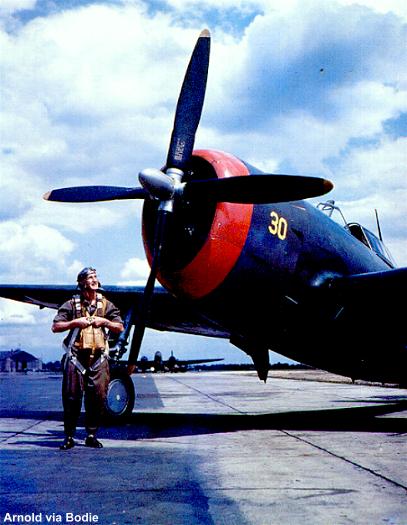 Lt. Earl Haywood of the 56th Fighter Group stands before his brand new P-47B.
Lt. Earl Haywood of the 56th Fighter Group stands before his brand new P-47B.
Later, these early fighters were redesignated RP-47B's and were used only for training.
Meanwhile the 56th was gradually transitioning to the large and powerful fighter.
Hub Zemke, promoted from Lieutenant to Major (skipping right past Captain), was named to command the
56th in September of 1942 (he had also commanded the 80th Fighter Group briefly, also at Farmingdale).
Zemke was not a man to be trifled with, being a no-nonsense flyer with ideas on fighter tactics that
were well ahead of his contemporaries. Shortly after assuming command, he was once again promoted,
now to Lt. Colonel. The training process was one filled with hair-raising washouts and several fatal
wrecks. It was here that the P-47 established itself as a remarkably tough aircraft. More than a few
pilots walked away from training crashes that would likely have been fatal had they been flying a less
substantial fighter, such as a P-40 or P-39.
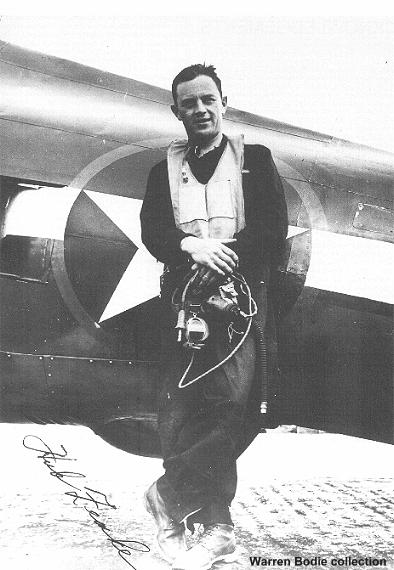 Hub Zemke with his P-47C, circa 1943.
Hub Zemke with his P-47C, circa 1943.
Gradually, the Group learned how to manage the Thunderbolt. Still, there
was a new problem beginning to appear. Powerful fighters such as the
P-47 and P-38 were encountering something relatively new to aviation;
compressibility. This new generation
of high-speed aircraft were capable of incredible speeds in a dive.
Compressibility is a term used to describe what happens when localized
airflow across a wing approaches transonic velocity. The resulting shock
wave could lock the elevators as
if in a vise. Pilots were running up against compressibility and they
were dying. P-47’s and P-38’s were being flown straight into the ground,
or even breaking up in flight. The learning curve was far steeper than
it had ever been before. Pilots
now had to learn how to deal with this new, terrifying phenomena.
Testing showed that the Thunderbolt could be flown out of a terminal
velocity dive as it descended into warmer air at lower altitudes. This
is because as the plane continues down,
the relative speed of sound goes up. Eventually, the aircraft’s Mach
number will drop (although its actual airspeed does not) and the shock
wave will dissipate, allowing the pilot to regain control again. Pilots
were instructed to pull off the throttle,
and avoid using too much up elevator trim. Too much trim, or too much
back pressure on the stick could over-stress the airframe when the
fighter began to respond to control inputs. Pilots who had flown the
P-47 into compressibility came away with
bruises to verify their adventure. The Thunderbolt’s ailerons would
flutter as it exceeded its critical Mach limits, causing the stick to
move violently from side to side; pummeling the inside of the pilot’s
thighs black and blue.
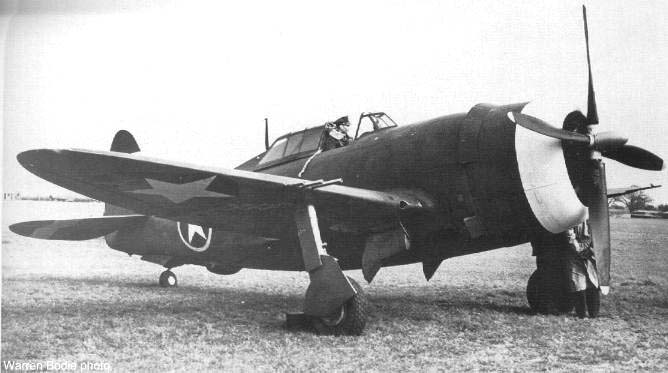 The 56th Fighter Group was greeted by
brand new P-47C fighters upon arrival in Britain.
The 56th Fighter Group was greeted by
brand new P-47C fighters upon arrival in Britain.
This Thunderbolt, a P-47C-2-RE, sits
with its new white banded cowling and tail stripes.
The 8th Air Force painted these white
markings on all P-47's in an effort to aid in identification.
On Thanksgiving day of 1942, the 56th was notified to prepare for deployment to Britain. Zemke was ready.
His squadrons were ready. In fact, Zemke was concerned that the Group was getting to the point of being
over-trained. It was time to prove what the P-47 could do in combat.
It was also time to see if his training methods and tactics would meet the challenge over German
controlled air space. Lt. Col. Zemke had a few pilots that he was worried about.
A few fellows were too aggressive. Some others had failed gunnery school.
Of these, Zemke doubted that one young man would survive very long in combat.
Robert Johnson nearly proved Zemke correct on his early missions.
However, Johnson would survive his first brushes with the Luftwaffe and go on to terrorize
the Luftwaffe like no one else in the 8th Air Force.
On January 3rd, 1943, the 56th boarded the HMS Queen Elizabeth for the trip across the Atlantic. Zemke
believed that the Groups weary P-47B fighters were being sent along as well. They would not be making
the trip. A new Fighter Group would be taking charge of the old B models. When the 56th arrived in Britain,
they discovered shiny new Thunderbolts waiting for them. These were the latest P-47C’s. Faster and better
handling than the old B’s, the new fighters were the best reception committee that Zemke could have asked for.
Unfortunately, things rapidly changed as the 56th were informed that their new fighters must be
surrendered to the 4th Fighter Group (formerly the Eagle Squadron). The 56th would have to wait to get their Thunderbolts.
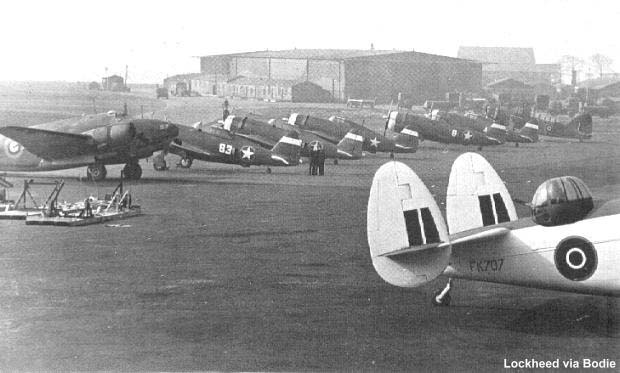 New P-47's arriving in Britain during early 1943
were assembled by the British Reassembly Division.
New P-47's arriving in Britain during early 1943
were assembled by the British Reassembly Division.
These Thunderbolts sit in company with a Lockheed Ventura and a Hudson.
In the background is a rare Brewster Bermuda.
Almost as soon as they set up shop in their new quarters, they began to hear
from RAF pilots that the P-47 just can’t hope to cut it with the “Jerry fighters”.
Even members of the 4th Fighter Group announced that the P-47 was a 'deathtrap', and were
quick to tell the pilots of the 56th that; “if our Spitfire Mk.V’s couldn’t
deal with the Focke Wulf 190, how can you expect to handle them in that huge P-47?”
Little did they know that not only could the Thunderbolt handle the Fw 190, it
would chase them from the sky over western Europe.
Go to Chapter Five
Return to the Planes and Pilots of WWII
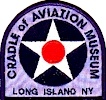 Return to the Cradle of Aviation Museum
Return to the Cradle of Aviation Museum

Unless otherwise indicated, all articles Copyright © Jordan Publishing Inc. 1998/1999.
Reproduction for distribution, or posting to a public forum without express written
permission is a violation of applicable copyright law. The Cradle of Aviation
Museum patch is the property of the Cradle of Aviation Museum.
Reproduction for distribution, or posting to a public forum without the written permission
of Jordan Publishing Inc. is prohibited.










